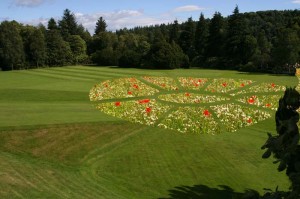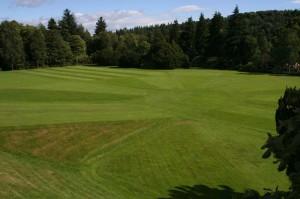

John Claudius Loudon concluded his 1831 visit to Drumlanrig with the alterations quoted below. Following upon my own visit in 2008, I would also like to proposed an alteration. It is shown in the illustrations of the lower terrace. It appears from the patterning of the grass that an elaborate parterre once filled the space. My proposal is to re-create the old bedding pattern with a wild flower meadow, as shown on the collage. It could be done by the simple expedient of ploughing the land and sowing a different wild-flower mix each year. The result, I believe would be beautiful, good for butterflies and a popular new attraction for Drumlanrig.
“Of all the alterations which we should wish to make on the grounds at Drumlanrig, there is none that strikes us as of half the importance as that of forming new approaches. There is one now going on; but a more preposterous under-taking of the kind we have seldom or never witnessed in any country. An attempt is made, or was making in August, 1831, to ascend a steep acclivity directly in front of the house; a still more hopeless task than that of cutting the rock into terraces, above related by Gilpin, by the old Duke of Queensberry. The duke did succeed, and the terraces were formed, and now exist; but this approach never can form an easy ascent; and we maintain that, even if it did, it would be in the very worst taste imaginable in the given situation; for this specific reason, that it would show all the striking beauties of the spot before entering the house. Now, we hold it to be a fundamental principle, in laying out grounds, that the grand beauties of every situation should be first shown to the stranger from the drawing-room windows. If this be not a fundamental principle, we should be glad to know on what reasons either the situation for a house is fixed on, or the direction of a road to it islaid out. There are many points in which a stranger taking a cursory glance at a place may be mistaken; but, if he has his eyes open, he never can err in forming an opinion as to the approach. As to the terraces we certainly have no wish to alter them. At the time Gilpin wrote, terraces were common, and the great rage was for nature and the picturesque. That rage has now subsided; and in landscape-gardening, as in architecture, and in other arts which combine beauty with utility, reason is the governing principle.”
